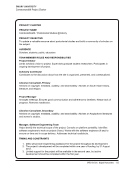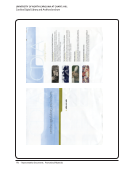SPEC Kit 326: Digital Humanities · 119
Rice University
Digital Library Initiative Application Profile
3
Standards
Metadata format and structure should be prepared according to the Dublin Core Metadata Best
Practices, published by the Collaborative Digitization Program (CDPDCMBP),
(http://www.cdpheritage.org/). Use qualifiers as needed.
Guidelines for the creation of bibliographic metadata
The below list is a starting sample set of elements and qualifiers. Individual projects should
customize this list to meet the information needs and specific collection characteristics.
element.qualifer
Provide data value description. Note any data standards. Denote if optional or mandatory entry.
Denote if multiple values allowed. Provide number of examples as beneficial to illustrate
options.
Example:
Note: Insert notes as needed.
contributor
Recommended to use qualifier to denote roles. Some example roles may include: author, editor,
publisher, photographer, composer, performer, transcriber, illustrator, etc.
Example:
Note: Proper names --The latest version of CDPDCMBP recommends
using the creator element to denote primary entities responsible for
creating the content of the resource and the contributor element to
denote any secondary persons making intellectual contributions.
This is a recent change from prior versions of CDPDCMBP. The
current DSpace configuration is based on earlier versions and as a
consequence, only data in the contributor field is used to generate
the author browse and search function. Data in the creator field
serves as display only. Therefore all proper names for an artifact
will use the contributor element with roles denoted by a qualifier
(e.g. contributor.author contributor.editor etc). At some future
date, when the configuration of Dspace is updated to reflect the
newer guidelines, then a mass conversion of contributor to creator
element may take place.
coverage
insert guidelines here
Example:
date.issued
Use standard: Date and Time Formats (W3C-DTF) http://www.w3.org/TR/NOTE-datetime.
Single date value only.
Example:
Rice University
Digital Library Initiative Application Profile
3
Standards
Metadata format and structure should be prepared according to the Dublin Core Metadata Best
Practices, published by the Collaborative Digitization Program (CDPDCMBP),
(http://www.cdpheritage.org/). Use qualifiers as needed.
Guidelines for the creation of bibliographic metadata
The below list is a starting sample set of elements and qualifiers. Individual projects should
customize this list to meet the information needs and specific collection characteristics.
element.qualifer
Provide data value description. Note any data standards. Denote if optional or mandatory entry.
Denote if multiple values allowed. Provide number of examples as beneficial to illustrate
options.
Example:
Note: Insert notes as needed.
contributor
Recommended to use qualifier to denote roles. Some example roles may include: author, editor,
publisher, photographer, composer, performer, transcriber, illustrator, etc.
Example:
Note: Proper names --The latest version of CDPDCMBP recommends
using the creator element to denote primary entities responsible for
creating the content of the resource and the contributor element to
denote any secondary persons making intellectual contributions.
This is a recent change from prior versions of CDPDCMBP. The
current DSpace configuration is based on earlier versions and as a
consequence, only data in the contributor field is used to generate
the author browse and search function. Data in the creator field
serves as display only. Therefore all proper names for an artifact
will use the contributor element with roles denoted by a qualifier
(e.g. contributor.author contributor.editor etc). At some future
date, when the configuration of Dspace is updated to reflect the
newer guidelines, then a mass conversion of contributor to creator
element may take place.
coverage
insert guidelines here
Example:
date.issued
Use standard: Date and Time Formats (W3C-DTF) http://www.w3.org/TR/NOTE-datetime.
Single date value only.
Example:
































































































































































































